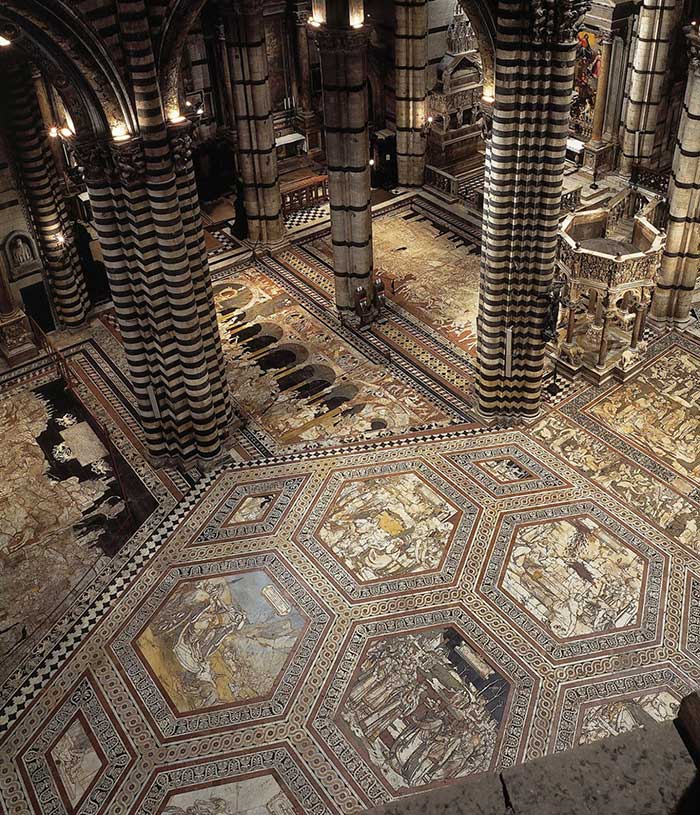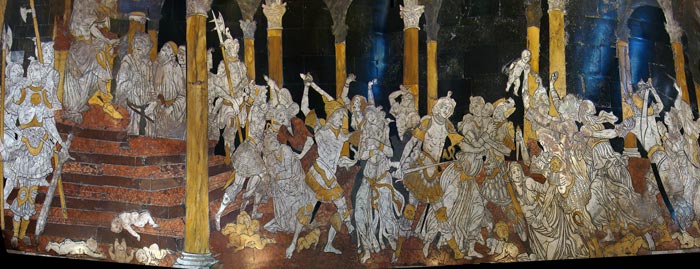| |
|
The Cathedral of Siena contains numerous masterpieces from every epoch. A work that in many respects is exceptional, is the floor, "the most beautiful ... largest and most magnificent ... that ever was made" in the words of Giorgio Vasari.[1] Crafted by about forty artists and artisans between the 14th and 16th centuries, the 56 panels that constitute the floor vary in size and shape – most of them have a rectangular shape, some a hexagon or a rhombus one – and are made mainly by two different techniques: one known as graffito (tiny holes and cutting lines created in the marble and then filled with black stucco and mineral pitch) and the one called marble intarsia (black, white, green, red and blue marble employed in much the same manner as wood inlaying).
The extraordinary inlaid marble mosaic floor of Siena’s Cathedral were unveiled on August 18. The uncovered floor can only be seen for a period of six to ten weeks each year, generally including the month of September. The rest of the year, they are covered and only a few are on display.
But as of 1st of March 2014, following lengthy restoration, visitors are able to admire the ‘heavens’ of the Cathedral, and are offered a panoramic view of the nave and the uncovered marble floors. A series of rooms that have never been open to the public, where no one has entered for centuries, except for the workmen directed by a succession of great architects who over the centuries left evidence in projects and sketches, at times drawn directly on the walls.[1]
The Mosaic floor and the Porta del Cielo
From August 18 to October 27, 2014
Visiting the Mosaic floor and the Porta del Cielo in Siena Cathedral Opening times:
The Gate of Heaven | From March until Octoberr 31 | 10.30am – 7.30pm, Sundays and holidays 9.30am - 6pm The Gate of Heaven
After extensive renovation, from March 1, 2014, you can see the 'sky' of the cathedral, a series of rooms never open to the public.
Strongly desired by the Opera della Metropolitana di Siena, the initiative is organised by Opera – Civita Group.
Opera Civita Group manages the booking, information and guided tours services for the Cathedral of Siena complex and, for the extraordinary opening of the ‘Gate of Heaven’, proposes cultural packages that enrich the city’s touristic offer.
Tickets: www.operaduomo.siena.it
Information and Booking
T. +39 0577 286300 (Monday to Friday, 9 am to 5 pm)
Email: opasiena@operalaboratori.com
|
|
|
|
|
| |
|
Siena was declared a UNESCO World Heritage Site in 1995. The inlaid marble mosaic floor is one of the most ornate of its kind in Italy, covering the whole floor of the cathedral. This undertaking went on from the 14th to the 16th centuries, and about forty artists made their contribution. The floor consists of 56 panels in different sizes. Most have a rectangular shape, but the later ones in the transept are hexagons or rhombuses. They represent the sibyls, scenes from the Old Testament, allegories and virtues. Most are still in their original state. The earliest scenes were made by a graffito technique: drilling tiny holes and scratching lines in the marble and filling these with bitumen or mineral pitch. In a later stage black, white, green, red and blue marble intarsia were used. This technique of marble inlay also evolved during the years, finally resulting in a vigorous contrast of light and dark, giving it an almost modern, impressionistic composition.
The earliest panel was probably the Wheel of Fortune (Ruota della Fortuna), laid in 1372 (restored in 1864). The She-Wolf of Siena with the emblems of the confederate cities (Lupa senese e simboli delle città alleate) probably dates from 1373 (also restored in 1864). The Four Virtues (Temperanza, Prudenza, Giustizia and Fortezza) and Mercy (Misericordia) date from 1406, as established by a payment made to Marchese d'Adamo and his fellow workers. They were the craftsmen who executed the cartoons of Sienese painters.
The first known artist working on the panels, was Domenico di Niccolò dei Cori, who was in charge of the cathedral between 1413 and 1423. We can ascribe to him several panels such as the Story of King David, David the Psalmist and David and Goliath. His successor as superintendent, Paolo di Martino, completed between 1424 and 1426 the Victory of Joshua and Victory of Samson over the Philistines.
In 1434 the renowned painter Domenico di Bartolo continued with a new panel Emperor Sigismund Enthroned (Imperatore Sigismundo in trono). The Holy Roman Emperor Sigismund was popular in Siena, because he resided there for ten months on his way to Rome for his coronation. Next to this panel, is the composition in 1447 (probably) by Pietro di Tommaso del Minella of the Death of Absolom (Morte di Assalonne).
The large panel, the Expulsion of Herod (Cacciata di Erode), was designed by Benvenuto di Giovanni in 1484-1485. The Story of Fortuna, or Hill of Virtue (Allegoria della Fortuna), by Pinturicchio in 1504, was the last one commissioned by Aringhieri. This panel also gives a depiction of Socrates.
Domenico Beccafumi, the most renowned Sienese artist of his time, worked on cartoons for the floor during thirty years (1518–1547). Half of the thirteen Scenes from the Life of Elijah, in the transept of the cathedral, were designed by him (two hexagons and two rhombuses). The eight meter long frieze Moses Striking water from the Rock was executed by him in 1525. The bordering panel, Moses on Mount Sinai was laid in 1531. His final contribution was the panel in front of the main altar: the Sacrifice of Isaac (1547).
Legend has it that Siena was established by Senius, son of Remus and nephew of Romulus. The Roman origin accounts for the town's emblem, a she-wolf suckling the infants Romulus and Remus. According to legend, Siena was founded by Senius and Aschius, the two sons of Remus, who was in turn the brother of Romulus, after whom Rome was named. Statues and other artwork depicting a she-wolf suckling the young twins Romulus and Remus can be seen all over the city of Siena.
|
|
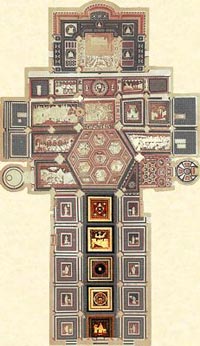
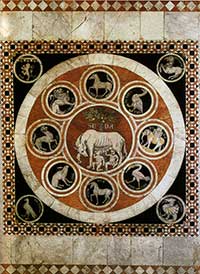
The She-Wolf of Siena with the emblems of the confederate cities
|
Giovanni di Stefano, Hermes Trismegistus, founder of human wisdom
|
An inscription at the entrance of the nave invites the visitor to assume a behaviour consonant for a person about to enter a holy temple: CASTISSIMUM VIRGINIS TEMPLUM CASTE MEMENTO INGREDI (Remember to enter chastely inside the very chaste temple of the Virgin). Observe the inlaid floor panel depicting Hermes Trismegistus, founder of human wisdom (executed by Giovanni di Stefano in 1488) which, along with The Sibyls (1482-83) portrayed in the aisles, is part of the same iconographic programme inspired by the Divinae Institutiones by Lactantius, a Christian author of the IV century.[1]
|
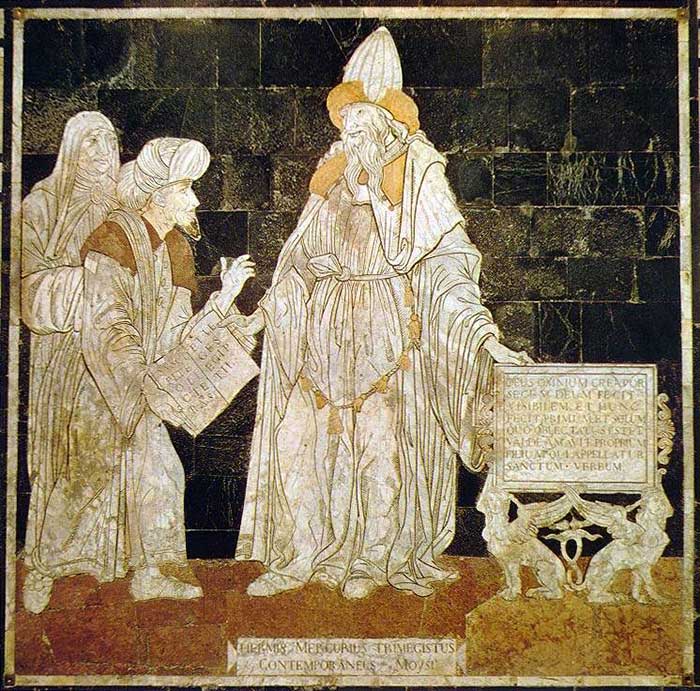 |
Giovanni di Stefano, Hermes Trismegistus, founder of human wisdom
|
Past the panel of Hermes in the nave, we come to the She-wolf nursing the twin brothers, inside a circle which is connected to eight other smaller tondos that show the emblems of cities in Central Italy. This panel is a 1865 reconstruction by Leopoldo Maccari, while the original which survives in several fragments in the Museo dell'Opera was dated 1373. This area of the floor, the only one to have been done in mosaic instead of marble intarsia, is probably the oldest, precisely for the different technique employed. Already in the Middle Ages, the She-wolf became the symbol of the city of Siena, tied to the mythological tale of the city's founding by Aschius and Senius, sons of Remus. Note the fig tree (Ficus Ruminalis) behind the animal where, according to tradition, the shepherd Faustulus found Romulus and Remus after they had been abandoned along the banks of the Tiber River.
|
 |
One of the earliest panels in the inlaid mosaic floor of the Cathedral, the She-Wolf of Siena
|
| |
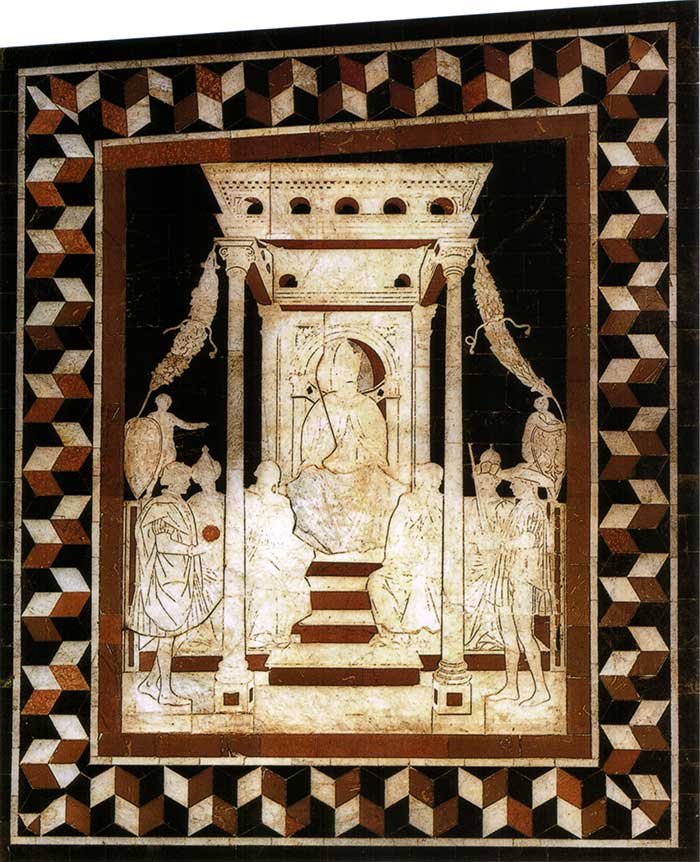 |
Domenico di Bartolo, Emperor Sigismund Enthroned (Imperatore Sigismundo in trono)
|
The next panel dates from 1473: Stories from the Life of Judith and the Liberation of Bethulia (Liberazione di Betulia) (probably) by Urbano da Cortona.
In 1480 Alberto Aringhieri was appointed superintendent of the works. From then on, the mosaic floor scheme began to make serious progress. Between 1481 and 1483 the ten panels of the Sibyls were worked out. A few are ascribed to eminent artists, such as Matteo di Giovanni (The Samian Sibyl), Neroccio di Bartolomeo de' Landi (Hellespontine Sibyl) and Benvenuto di Giovanni (Albunenan Sibyl). The Cumaean, Delphic, Persian and Phrygian Sibyls are from the hand of the obscure German artist Vito di Marco. The Erythraean Sibyl was originally by Antonio Federighi, the Libyan Sibyl by the painter Guidoccio Cozzarelli, but both have been extensively renovated. The large panel in the transept The Slaughter of the Innocents (Strage degli Innocenti) is probably the work of Matteo di Giovanni in 1481.
|
|
Massacre (Slaughter) of the Innocents, by Matteo di Giovanni
|
|
|
|
Pinturricchio, Allegory of the Hill of Wisdom
|
|
|
Central to the design of the Siena cathedral pavement is the Mountain of Wisdom. It is located among Sages like Hermes Trismegistus and the Sibyls. O
|
 |
Pinturricchio, Allegory of the Hill of Wisdom, Siena Duomo, floor mosaic
|
| The panel designed by Pinturicchio (the fourth in the nave), shows the personification of Fortune: a nude girl who, in her right hand, holds a horn of plenty, while in her left hand she holds up a wind-swollen sail as though it were an insignia. Her balance is unstable: her right foot rests on a sphere, while her left is set on an ungovernable boat with a broken mast. Following a turbulent journey, Fortune has succeeded in putting several Sages ashore a rocky island, visible from shore to shore. The Sages climb up a footpath over stony ground and through wild vegetation, their way fraught with dangers, including serpents and other reptiles. On top of the mountain that the wise men attempt to climb sits a female figure: Wisdom or Virtue. With her left hand, the woman offers a book to Crates of Thebes who strips himself of all factitious goods, throwing a basket full of jewels into the sea: chains, precious stones, and rings rendered with a calligraphic flavour, while with her right hand, she offers a palm to Socrates. The message of the allegory on the floor is quite evident: the road to Wisdom is a difficult one but after overcoming harsh trials, one attains serenity, quies, symbolised by the plateau covered with bushes in flower, and stated in the inscription which invites one to climb the harsh hill.[1]
|
|
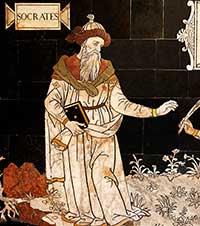
Detail from the mosaic panel Allegory of the Mount of Knowledge designed by Pinturicchio. It depicts the ancient philosopher Socrates.
|
Guidoccio Cozzarelli, Libyan Sibyl
|
|
|
Most of the panels have a rectangular shape, but the later ones, to be found in the transept, are hexagons or rhombuses. They represent the sibyls, scenes from the Old Testament, allegories and virtues.
In accordance with the Varronian canon, the Sibyls were ten in number (five for each aisle), and were named after their geographic location: the Persian, Hellespontine, Erythraean, Phrygian, Samian, and Delphic Sibyls for the Eastern and Greek world; the Libyan Sibyl for Africa; and then those of the West (with reference to Italy): the Cumaean or Cimmerian Sibyl, the Cumaean Sibyl (of Virgil) and the Tiburtine Sibyl.[1]
|
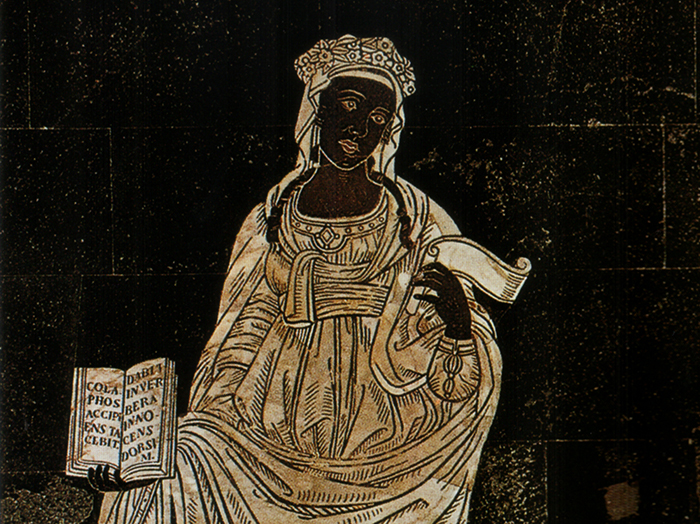 |
Guidoccio Cozzarelli, Libyan Sibyl, mosaic floor (detail) 148, Siena, Cathedral of Santa Maria Assunta, left nave
|
The Sibyls, for example, are typical characters from classical antiquity linked to Apollo. The Libyan Sibyl, named Phemonoe, was the prophetic priestess presiding over the Zeus Ammon Oracle (Zeus represented with the horns of Ammon) at Siwa Oasis in the Libyan Desert. The word Sibyl comes (via Latin) from the ancient Greek word sibylla, meaning prophetess.
The word Sibyl comes (via Latin) from the ancient Greek word sibylla, meaning prophetess. There were many Sibyls in the ancient world, but the Libyan Sibyl, in Classical mythology, Lamia, foretold the "coming of the day when that which is hidden shall be revealed."
In Pausanias Description of Greece, the sibyl names her parents in her oracles:
I am by birth half mortal, half divine;
An immortal nymph was my mother, my father an eater of grain;
On my mother's side of Idaean birth, but my fatherland was red
Marpessus, sacred to the Mother, and the river Aidoneus. (Pausanias 10.12.3)
|
|
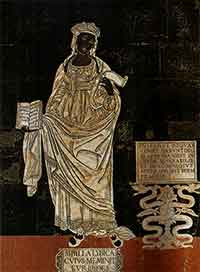
The Libyan Sibyl by the painter Guidoccio Cozzarelli |

[1] Source: www.operaduomo.siena.it |
|
|
|
|
![]()
![]()
![]()
![]()
![]()

